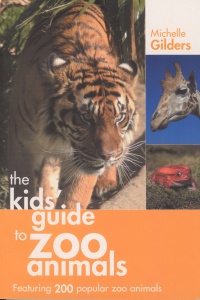| ________________
CM . . .
. Volume XI Number 6 . . . .November 12, 2004
excerpt:
Written in field guide format, The Kids' Guide to Zoo Animals book is designed to help youngsters understand zoo animals. The book begins with an explanation of the vital role that zoos play in informing the public about wildlife and the threats facing animals and their habitats. It lists tips for making the most out of a visit to the zoo and explains scientific names and terms such as "vulnerable" and "near threatened" as they apply to endangered animals. Biologist/photographer Michelle Gilders provides profiles, all of them colour-coded, on 200 animals, ranging from the popular to the lesser known, such as the babirusa (a pig-like animal with backward curving tusks), the klipspringer (a little antelope) and the axolotl (a type of salamander). A single page is devoted to each animal with information about the animal's size, lifespan, physical characteristics, diet, habitat, behaviour and status as well as its scientific classification. There are several colour photographs of the animal along with a world map showing the animal's range. Several factors contribute to the book's being easy to use: the colour-coding of the animal groups, coloured headings for each of the sub-topics, and a unified layout. Animals are not listed in alphabetical order, but, rather, in families. For example, all of the monkeys are listed consecutively, as are the big cats. This structure makes sense as most zoos have areas devoted to certain types of animals because the animals have similar requirements. Therefore, visitors armed with this guide will be able to find information easily as they tour the zoo (an added bonus is the size of the guide which is perfect for carrying in a tote or backpack). There are 500 photographs and 200 maps. A table of contents, an index and a very detailed glossary are also included. Highly Recommended. Gail Hamilton is a teacher-librarian at Bird's Hill School in East St. Paul, MB.
To comment
on this title or this review, send mail to cm@umanitoba.ca.
Copyright © the Manitoba Library Association. Reproduction for personal
use is permitted only if this copyright notice is maintained. Any
other reproduction is prohibited without permission.
NEXT REVIEW |
TABLE OF CONTENTS FOR THIS ISSUE
- November 4, 2004.
AUTHORS |
TITLES |
MEDIA REVIEWS |
PROFILES |
BACK ISSUES |
SEARCH |
CMARCHIVE |
HOME |
